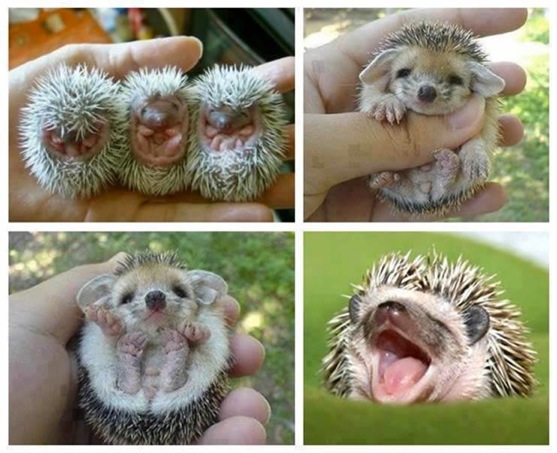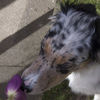Cuteness at it's best:
Jan 16, 2016 10:44:47 #
Jan 16, 2016 15:07:31 #
ebbote wrote:
They're adorable! Thanks for posting them.Sent to me by a friend.
Jan 16, 2016 15:39:58 #
Cuteness overload!!! I'd better take a pill.
Great shots, Earnest, even if you didn't do them, lol!
Great shots, Earnest, even if you didn't do them, lol!
Jan 16, 2016 17:44:11 #
You are welcome and thank you Lev.
lev29 wrote:
They're adorable! Thanks for posting them.
Jan 16, 2016 17:44:58 #
Thank you Randy.
Treepusher wrote:
Cuteness overload!!! I'd better take a pill.
Great shots, Earnest, even if you didn't do them, lol!
Great shots, Earnest, even if you didn't do them, lol!
Jan 16, 2016 17:46:21 #
ebbote wrote:
Sent to me by a friend.
Very precious-Thanks for posting, Earnest!
Jan 16, 2016 17:49:16 #
You are very welcome Swamp.
Swamp-Cork wrote:
Very precious-Thanks for posting, Earnest!
Jan 17, 2016 07:29:37 #
Jan 17, 2016 08:01:51 #
ebbote wrote:
Sent to me by a friend.
Super cute! When you said "sent," did you mean the pictures or the animals? :D
Jan 17, 2016 08:43:35 #
Jan 17, 2016 09:33:50 #
Yes, only the pictures, thanks for looking Jerry.
jerryc41 wrote:
Super cute! When you said "sent," did you mean the pictures or the animals? :D
Jan 17, 2016 10:36:56 #
Cuties for sure. Are the hairs soft or prickly? I do not know a thing about our mascot!
Rick
Rick
Jan 17, 2016 11:04:23 #
Good question Rick, I have been wondering the same thing, I hope we get
an answer from someone here.
an answer from someone here.
RickM1950 wrote:
Cuties for sure. Are the hairs soft or prickly? I do not know a thing about our mascot!
Rick
Rick
Jan 17, 2016 12:52:22 #
Facts about hedgehogs
The hedgehog got its name because of its peculiar foraging habits. They root through hedges and other undergrowth in search of their favourite food - small creatures such as insects, worms, centipedes, snails, mice, frogs, and snakes. As it moves through the hedges it emits pig-like grunts thus, the name hedgehog.
The hedgehog is nocturnal, coming out at night and spending the day sleeping in a nest under bushes or thick shrubs.
Their coats are thick and spiny, providing them with a formidable defence against predators such as the fox. When they feel alarmed or intimidated, they will curl up into a spiny ball to protect its vulnerable stomach.
They have about 5000 spines. Each spine lasts about a year then drops out and a replacement grows.
The spines are hollow and springy with a flexible neck and they are erected by muscles. At the base there is a smooth ball which bends on impact.
There may be up to 500 fleas on one hedgehog but the specific hedgehog flea (known as Archaepsylla erinacei) rarely bites humans.
They also have a habit when stimulated by a strong smell or taste to self-anoint this means they cover their prickles in foamy saliva. No-one is certain why it does this.
While hunting for food, they rely primarily upon their senses of hearing and smell because their eyesight is weak though their eyes are adapted for night-time vision.
They have a particularly long, extending snout beyond the front of their mouth which they use to help them forage for food.
The diet of a hedgehog has claimed it the reputation as being the gardeners friend as it includes so many pests. Frequently food put out for dogs and cats in town and city gardens also provides a meal for them and it is certainly a good way to encourage one into your own garden.
Hedgehogs are usually solitary, usually pairing up only to mate. When they mate they often make loud snuffling noises. The male circles the female, sometimes for hours, to persuade her to mate. They will separate thereafter and the male takes no part in rearing the family.
The young are born in litters ranging from one to eleven. They remain with their mothers for only four to seven weeks before heading out on their own. Among the predators females must guard against during this period are other male hedgehogs, which will sometimes prey upon the young of their species. Hedgehog mothers have also been known to eat their young if the nest is disturbed, though they sometimes simply move them to a new nest.
Baby hedgehogs are born blind after 32 days and their spines are soft. However a late litter born in September seldom survive their first winter. The young are suckled by their mother until they are able to hunt for themselves. After about four weeks, the mother will take the young out on their first foraging trip and after ten days, the family will separate.
European hedgehogs in the UK hibernate throughout winter. They feed as much as possible during the autumn and in around October build its nests of leaves and grass in which to hibernate.
There are 15 species of hedgehog.
Hedgehogs in cold climes hibernate over the winter. In warmer climates such as deserts they sleep through heat and drought in a similar process called aestivation. In more temperate areas they remain active all year.
The hedgehog got its name because of its peculiar foraging habits. They root through hedges and other undergrowth in search of their favourite food - small creatures such as insects, worms, centipedes, snails, mice, frogs, and snakes. As it moves through the hedges it emits pig-like grunts thus, the name hedgehog.
The hedgehog is nocturnal, coming out at night and spending the day sleeping in a nest under bushes or thick shrubs.
Their coats are thick and spiny, providing them with a formidable defence against predators such as the fox. When they feel alarmed or intimidated, they will curl up into a spiny ball to protect its vulnerable stomach.
They have about 5000 spines. Each spine lasts about a year then drops out and a replacement grows.
The spines are hollow and springy with a flexible neck and they are erected by muscles. At the base there is a smooth ball which bends on impact.
There may be up to 500 fleas on one hedgehog but the specific hedgehog flea (known as Archaepsylla erinacei) rarely bites humans.
They also have a habit when stimulated by a strong smell or taste to self-anoint this means they cover their prickles in foamy saliva. No-one is certain why it does this.
While hunting for food, they rely primarily upon their senses of hearing and smell because their eyesight is weak though their eyes are adapted for night-time vision.
They have a particularly long, extending snout beyond the front of their mouth which they use to help them forage for food.
The diet of a hedgehog has claimed it the reputation as being the gardeners friend as it includes so many pests. Frequently food put out for dogs and cats in town and city gardens also provides a meal for them and it is certainly a good way to encourage one into your own garden.
Hedgehogs are usually solitary, usually pairing up only to mate. When they mate they often make loud snuffling noises. The male circles the female, sometimes for hours, to persuade her to mate. They will separate thereafter and the male takes no part in rearing the family.
The young are born in litters ranging from one to eleven. They remain with their mothers for only four to seven weeks before heading out on their own. Among the predators females must guard against during this period are other male hedgehogs, which will sometimes prey upon the young of their species. Hedgehog mothers have also been known to eat their young if the nest is disturbed, though they sometimes simply move them to a new nest.
Baby hedgehogs are born blind after 32 days and their spines are soft. However a late litter born in September seldom survive their first winter. The young are suckled by their mother until they are able to hunt for themselves. After about four weeks, the mother will take the young out on their first foraging trip and after ten days, the family will separate.
European hedgehogs in the UK hibernate throughout winter. They feed as much as possible during the autumn and in around October build its nests of leaves and grass in which to hibernate.
There are 15 species of hedgehog.
Hedgehogs in cold climes hibernate over the winter. In warmer climates such as deserts they sleep through heat and drought in a similar process called aestivation. In more temperate areas they remain active all year.
Jan 17, 2016 13:58:04 #
Thanks for the info Rick.
RickM1950 wrote:
Facts about hedgehogs br br The hedgehog got its ... (show quote)
If you want to reply, then register here. Registration is free and your account is created instantly, so you can post right away.







